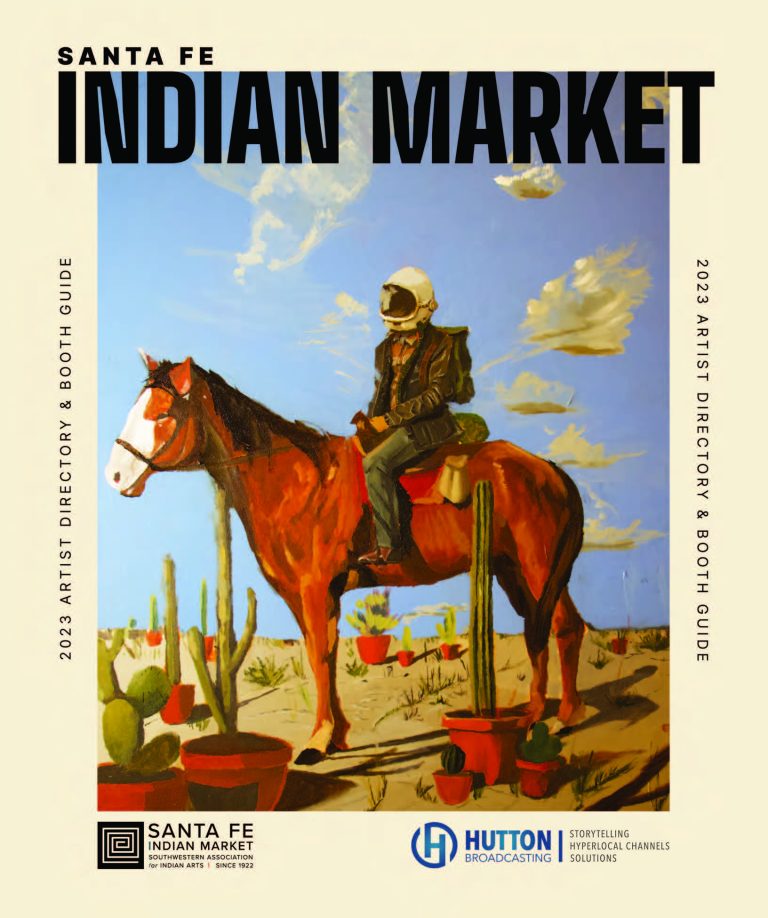What is SWAIA?
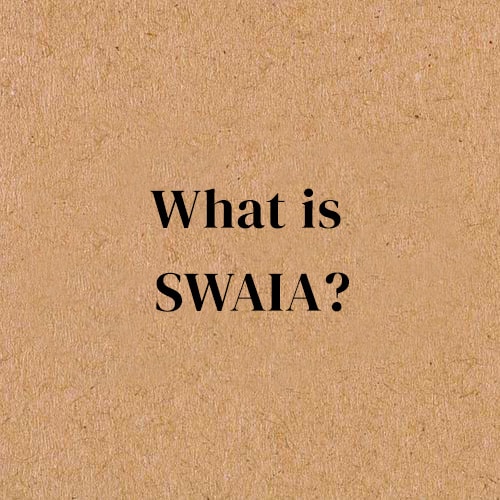
Bringing Native arts to the world by inspiring artistic excellence, fostering education, and creating meaningful partnerships
The History of Santa Fe Indian Market and SWAIA
For the past century, Santa Fe Indian Market has brought together the most gifted Native American artists from the U.S. with millions of visitors and collectors from around the world. The extended weekend of beauty and celebration ranks as the world’s largest and most highly acclaimed Native American arts show and as New Mexico’s largest attended annual weekend event.
Santa Fe Indian Market is widely known as the place where Native American art and culture meets the world. As a primary vehicle for showcasing Native American arts, Indian Market also serves as a principal means for advancing the careers of many of today’s noted American Indian artists. Jamie Okuma (Luiseno, Shoshone/Bannock), SWAIA Best of Show winner 2000/2002, states, “SWAIA’s Indian Market awards have given me my career.” Lonnie Vigil, distinguished micaceous potter from Nambé Pueblo (Best of Show 2001) eloquently describes Indian Market as, “the place where the makers and receivers of our works come together in a special appreciation of the art.” Perhaps summing it up for generations of artists who have participated in Indian Market, SWAIA Fellowship Winner Michele Laughing (Navajo) shares, “It has made my journey possible.”
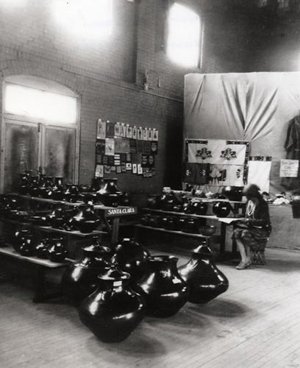
Each August, the historic city of Santa Fe, NM becomes the Santa Fe Indian Market, enveloping the town’s central Plaza and surrounding streets. In addition, hundreds of gallery openings, art shows and related events take place during the weekend of Indian Market and during the two weeks immediately preceding it. Indian art collectors and artists from around the world make the pilgrimage to Santa Fe – whether they intend to buy or not. The Southwestern Association for Indian Arts (SWAIA) sponsors the event, which is estimated to bring more than 115,000 people and over $160 million in revenues to the state and region.
Today’s SWAIA Santa Fe Indian Market is the outgrowth of a series of remarkable people and events. One story is about the Museum of New Mexico and a group of remarkable women who formed themselves into a political action organization to establish and protect human rights for New Mexico’s Indian population. It was in 1922 that the Indian Fair was created by the Museum of New Mexico as part of the Santa Fe Fiesta celebration. The Museum continued to sponsor the Indian Fair until 1926. In 1936 the New Mexico Association on Indian Affairs took over the event. It was also in 1922 that the New Mexico Association on Indian Affairs (NMAIA) was founded to help fight the U.S. Senate’s proposed Bursum Bill, which would have illegally given an enormous amount of Pueblo land to Spanish and American squatters The first Indian Fair in 1922 was developed by the Museum of New Mexico as the ethnological display of the Santa Fe Fiesta. In 1919, Museum Director Edgar Lee Hewett had revived the Fiesta as an annual celebration to help promote tourism. His inclusion of the Indian Fair in the Fiesta Pageant was reminiscent of previous World’s Fairs, and in particular, the San Diego Exposition’s anthropological exhibits and the Santa Fe Railway’s living exhibition, the “Painted Desert.”
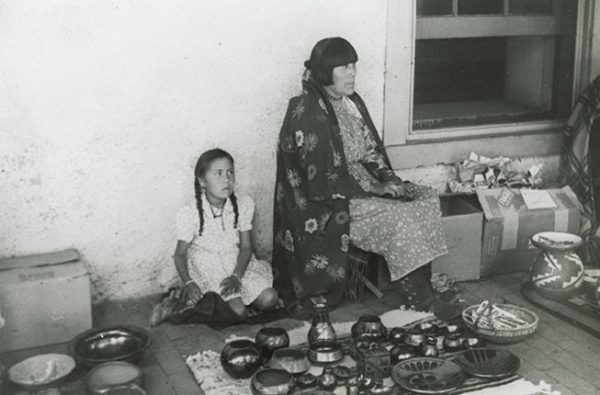 By the time of the first Indian Fair, museum curator and assistant director Kenneth Chapman had worked extensively with many potters (in particular, Maria Martinez and her family from San Ildefonso) to understand their work. It was thought that a Fair would provide the opportunity to simultaneously educate the potter and the buyer to appreciate Indian art as it had been before its transformation by non-Native cultures into curios and souvenirs.
By the time of the first Indian Fair, museum curator and assistant director Kenneth Chapman had worked extensively with many potters (in particular, Maria Martinez and her family from San Ildefonso) to understand their work. It was thought that a Fair would provide the opportunity to simultaneously educate the potter and the buyer to appreciate Indian art as it had been before its transformation by non-Native cultures into curios and souvenirs.
Edgar Hewett opened the first Southwest Indian Fair and Industrial Arts and Crafts Exhibition on September 4, 1922, with the simple words, “The hour has arrived.” He then went on to speak about the “importance of fostering and preserving the crafts of the Indian.” Hewett was followed by Francis LaFleshe, eminent ethnologist and Omaha Indian, who addressed the need for systematic production, steady markets, and the maintenance of adequate prices if the movement to revive Indian crafts was to be a success. Finally, Tsianina, Cherokee songstress, sang several songs of her people.
The Indian Fair was held indoors at the National Guard Armory behind the Palace of the Governors building. An admission fee was charged, except to Indian people. The patio of the Palace of the Governors was used for the following demonstrations: Navajo weaving, sandpainting and silver jewelry, pottery, beadwork, and cooking on a kitchen range, and Indian dances.
Inside the Armory building, the walls were covered with watercolor paintings on paper and Navajo rugs. The Fort Beck Sioux Reservation had sent a collection of older beaded garments which earned the award for best tribal display, winning $15 and the Albert Bacon Fall Trophy Cup. Traders, Indian agency superintendents, and teachers were encouraged to send entries to the Fair. Local potters brought their own entries to Santa Fe. All entries were juried and judged by Chapman and two other Museum curators. Each pueblo comprised a single category, being awarded a first prize of $5 and a second prize of $3.
From 1923 to 1926 the Indian Fairs remained a part of Fiesta. The Fair’s objectives remained unchanged: to preserve and revive old arts, to keep the arts of each tribe as distinctive as possible, to help to authenticate, to locate markets, and to obtain fair prices. It was during these years that the Pueblo pottery revival took firm hold, in large part due to the marketing efforts of the Museum and Fair.
In 1927 an independent Southwest Indian Fair committee took over the management of the Indian Fair from the Museum with Chapman remaining as a central figure. A large concern of the Fair’s organizers had been for arranging camping for the Fair’s participants. Each year about $400 was spent on establishing a campground with tents and providing food.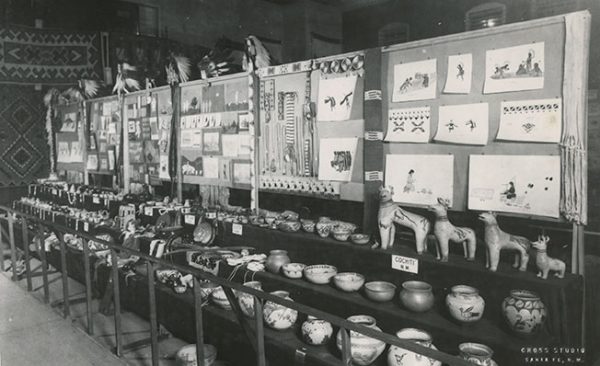
The last Indian Fair was held in 1931 in Santa Fe. This Fair included two important innovations: it was held outdoors under portal of the Palace of the Governors; and, most importantly, artists were expected to make their own sales rather than depending on the Committee members.
From 1932-1935, there were no fairs. Instead, judging competitions were held in the villages on saint day celebrations; at the Indian schools in Santa Fe and Albuquerque, various Pueblo Day schools; and at trader and Agency-organized tribal fairs at Zuni, Shiprock and Gallup’s Inter-Tribal Ceremonial. Committee members, Chapman, Amelia White, Margaret McKittrick, and others traveled from village to village and fair to fair hoping to discourage the production of “curios” through their sponsorship and awarding of cash prizes.
The Indian Market
In 1934 the NMAIA formally absorbed the Indian Fair committee as part of its Arts and Crafts Committee. To reach a broader audience, the NMAIA proposed educating the public about Indian pottery and other crafts through a series of articles in New Mexico Magazine, as well as returning the Fair to Santa Fe.
In 1936, Maria Chabot, NMAIA President Margretta Dietrich’s assistant, proposed an Indian Market be held under the Palace of the Governor’s portal and modeled on Mexican village outdoor markets. The Saturday markets were held for a period of eight consecutive weeks beginning in July. Artists were expected to sell their own work, and small stickers were attached to those pieces which the judges believed represented “good” Indian art. Chabot’s invitation to Maria Martinez, Tonita Pena (a Cochiti painter), and Severa Tafoya (a Santa Clara potter) to serve as judges was refused, telling Chabot “they could not judge each other.” The NMAIA provided bus transportation to and from Santa Fe for the Pueblo villages being featured.
While the Saturday markets ended in 1939, Fiesta Indian Market would continue until 1962. The Fiesta Market might be considered first modern Santa Fe Indian Market. Unlike the Saturday markets, it was a single weekend to which all Indian artists were invited, allowing all Indian people to participate and to sell whatever they brought.
The Fiesta Indian Markets continued to be plagued by the same problems as the previous Fairs and Markets. Plaza merchants resented the artists “cluttering up the front of their stores.” Chaos reigned under the portal for the artists as well. There were no space assignments; during the 1940s people began sleeping under the portal to retain their spots. Pueblo dance performances became the NMAIA’s and Pueblo peoples’ primary involvement in Santa Fe Fiesta Indian Market. Throughout the 1940s Chapman remained the head judge. First prize paid $3.00 while second paid $1.50; in 1949 prize money was returned to the 1920s levels of $5.00 for first, and $10.00 for best piece. In 1949 prizes were now given for the best articles in each class in the whole market, not to each pueblo as was done formerly. This put potters in competition with potters from the other villages, thus furthering a potter’s reliance on individual style over that of his or her community.
Through the 1950s prize money and winners would decrease from $148.00 and thirty-two in 1950 to $123.00 and twenty-seven in 1951, $133.00 and twenty-six in 1952, and $124.00 and twenty-four in 1953. The Fiesta Indian Market was shrinking in size; it had become an increasingly lower priority of the NMAIA in the years following World War II.
NMAIA member Gladys Augur kept the markets going for seventeen years until her resignation in 1959. Augur was not a collector, but rather politically active through the NMAIA, which viewed Market in educational and economic terms as a means of developing and sustaining economic opportunities for Indian communities.
In 1959 discussions began concerning the future of the organization. Fortuitously, trader Al Packard took an interest in continuing the markets along with Sallie and Bill Lippincott, Rex Arrowsmith, Marge Lambert, and Bertha Dutton. If not for Packard, the stagnant Markets would have withered from lack of organization. Certainly vendors would have continued to sit under the portal during Fiesta, as well as at other times, but the judging and prizes would have ended.
The New Mexico Association on Indian Affairs changed its name to the Southwestern Association on Indian Affairs in 1959. It was thought that this new name would more accurately indicate the territory covered by the association. However, with this name change they also dissolved themselves. This action symbolized a break with its political past as well as a generational change. Within five years Indian Market was the singular activity of the group and cultural heritage preservation became the principal objective of Indian Market.
A national interest in American Indian culture occurred during the 1960s, helping to forever change Indian Market. In addition, in 1962 the Institute of American Indian Arts was established in Santa Fe. Moreover, in 1962 the Market was moved to the weekend preceding Fiesta de Santa Fe because it was getting lost in the increasingly raucous celebration.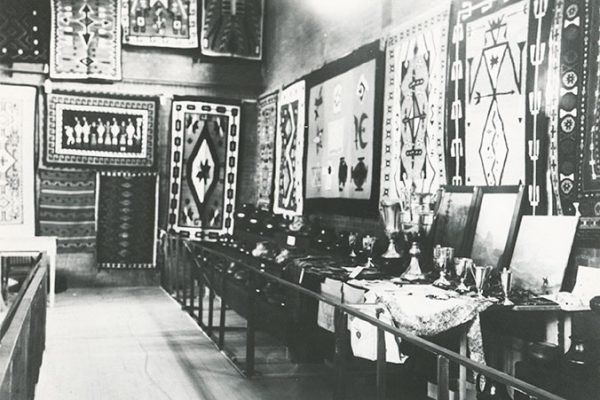
The first row of Indian Market booths appeared in 1964 on Palace Avenue in order to ease overcrowding. In 1965 two rows of twenty-five booths were added, and again in 1966 an additional twenty-five booths were added. This provided space for seventy-five artists on Palace Avenue in addition to the approximately one hundred artists under the portal.
Market’s drawing card had been created in 1936 with potters selling directly to customers without an intermediary. People began flocking to Santa Fe to meet the artists and potters who converged to sell to a generation of new-found customers. As a result in the 1970s, Indian Market overtook the Gallup Inter-Tribal Ceremonial as the premiere Indian art show.
The growth of Santa Fe Indian Market has been phenomenal over the past twenty-five years. In 1970 Market was under the portal and along the north and east sides of the Plaza. All 200 artists who showed up on Saturday morning were given a booth. In 1980 the Market included 330 booths in rows of three on all four sides of the plaza, and no space could be found for many more artists. In 2002 there are 625 booths and 1200 artists. Booths now extend up Washington and Lincoln Avenues as well as to Marcy Street and Cathedral Place. In 1970 there was $1835 in prize money and in 2002 over $65,500. The total income of the organization rose from $2,554 in 1970 to over one million dollars in 1996. In 1993, SWAIA’s Board of Directors voted to change the name of the organization to Southwestern Association for Indian Arts to more accurately reflect the focus of the Association’s work.
Now, 99 years after the first Indian Fair, the Southwestern Association for Indian Arts’ proud mission is “Bringing Native arts to the world by inspiring artistic excellence, fostering education, and creating meaningful partnerships.”
As SWAIA moves through the 21st Century with a world gaining deeper appreciation for American Indian arts and culture, it is poised for expanding its role through the creation of Markets worldwide, and through further developing its educational and training programs in support of Native American artists.
* Adapted from “History of the Santa Fe Indian Market” by Bruce Bernstein.
For the past century, Santa Fe Indian Market has brought together the most gifted Native American artists from the U.S. with millions of visitors and collectors from around the world. The extended weekend of beauty and celebration ranks as the world’s largest and most highly acclaimed Native American arts show and as New Mexico’s largest attended annual weekend event.
Santa Fe Indian Market is widely known as the place where Native American art and culture meets the world. As a primary vehicle for showcasing Native American arts, Indian Market also serves as a principal means for advancing the careers of many of today’s noted American Indian artists. Jamie Okuma (Luiseno, Shoshone/Bannock), SWAIA Best of Show winner 2000/2002, states, “SWAIA’s Indian Market awards have given me my career.” Lonnie Vigil, distinguished micaceous potter from Nambé Pueblo (Best of Show 2001) eloquently describes Indian Market as, “the place where the makers and receivers of our works come together in a special appreciation of the art.” Perhaps summing it up for generations of artists who have participated in Indian Market, SWAIA Fellowship Winner Michele Laughing (Navajo) shares, “It has made my journey possible.”
The History of Santa Fe Indian Market and SWAIA
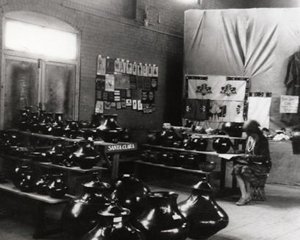
Each August, the historic city of Santa Fe, NM becomes the Santa Fe Indian Market, enveloping the town’s central Plaza and surrounding streets. In addition, hundreds of gallery openings, art shows and related events take place during the weekend of Indian Market and during the two weeks immediately preceding it. Indian art collectors and artists from around the world make the pilgrimage to Santa Fe – whether they intend to buy or not. The Southwestern Association for Indian Arts (SWAIA) sponsors the event, which is estimated to bring more than 115,000 people and over $160 million in revenues to the state and region.
Today’s SWAIA Santa Fe Indian Market is the outgrowth of a series of remarkable people and events. One story is about the Museum of New Mexico and a group of remarkable women who formed themselves into a political action organization to establish and protect human rights for New Mexico’s Indian population. It was in 1922 that the Indian Fair was created by the Museum of New Mexico as part of the Santa Fe Fiesta celebration. The Museum continued to sponsor the Indian Fair until 1926. In 1936 the New Mexico Association on Indian Affairs took over the event. It was also in 1922 that the New Mexico Association on Indian Affairs (NMAIA) was founded to help fight the U.S. Senate’s proposed Bursum Bill, which would have illegally given an enormous amount of Pueblo land to Spanish and American squatters The first Indian Fair in 1922 was developed by the Museum of New Mexico as the ethnological display of the Santa Fe Fiesta. In 1919, Museum Director Edgar Lee Hewett had revived the Fiesta as an annual celebration to help promote tourism. His inclusion of the Indian Fair in the Fiesta Pageant was reminiscent of previous World’s Fairs, and in particular, the San Diego Exposition’s anthropological exhibits and the Santa Fe Railway’s living exhibition, the “Painted Desert.”
 By the time of the first Indian Fair, museum curator and assistant director Kenneth Chapman had worked extensively with many potters (in particular, Maria Martinez and her family from San Ildefonso) to understand their work. It was thought that a Fair would provide the opportunity to simultaneously educate the potter and the buyer to appreciate Indian art as it had been before its transformation by non-Native cultures into curios and souvenirs.
By the time of the first Indian Fair, museum curator and assistant director Kenneth Chapman had worked extensively with many potters (in particular, Maria Martinez and her family from San Ildefonso) to understand their work. It was thought that a Fair would provide the opportunity to simultaneously educate the potter and the buyer to appreciate Indian art as it had been before its transformation by non-Native cultures into curios and souvenirs.
Edgar Hewett opened the first Southwest Indian Fair and Industrial Arts and Crafts Exhibition on September 4, 1922, with the simple words, “The hour has arrived.” He then went on to speak about the “importance of fostering and preserving the crafts of the Indian.” Hewett was followed by Francis LaFleshe, eminent ethnologist and Omaha Indian, who addressed the need for systematic production, steady markets, and the maintenance of adequate prices if the movement to revive Indian crafts was to be a success. Finally, Tsianina, Cherokee songstress, sang several songs of her people.
The Indian Fair was held indoors at the National Guard Armory behind the Palace of the Governors building. An admission fee was charged, except to Indian people. The patio of the Palace of the Governors was used for the following demonstrations: Navajo weaving, sandpainting and silver jewelry, pottery, beadwork, and cooking on a kitchen range, and Indian dances.
Inside the Armory building, the walls were covered with watercolor paintings on paper and Navajo rugs. The Fort Beck Sioux Reservation had sent a collection of older beaded garments which earned the award for best tribal display, winning $15 and the Albert Bacon Fall Trophy Cup. Traders, Indian agency superintendents, and teachers were encouraged to send entries to the Fair. Local potters brought their own entries to Santa Fe. All entries were juried and judged by Chapman and two other Museum curators. Each pueblo comprised a single category, being awarded a first prize of $5 and a second prize of $3.
From 1923 to 1926 the Indian Fairs remained a part of Fiesta. The Fair’s objectives remained unchanged: to preserve and revive old arts, to keep the arts of each tribe as distinctive as possible, to help to authenticate, to locate markets, and to obtain fair prices. It was during these years that the Pueblo pottery revival took firm hold, in large part due to the marketing efforts of the Museum and Fair.
In 1927 an independent Southwest Indian Fair committee took over the management of the Indian Fair from the Museum with Chapman remaining as a central figure. A large concern of the Fair’s organizers had been for arranging camping for the Fair’s participants. Each year about $400 was spent on establishing a campground with tents and providing food.
The last Indian Fair was held in 1931 in Santa Fe. This Fair included two important innovations: it was held outdoors under portal of the Palace of the Governors; and, most importantly, artists were expected to make their own sales rather than depending on the Committee members.
From 1932-1935, there were no fairs. Instead, judging competitions were held in the villages on saint day celebrations; at the Indian schools in Santa Fe and Albuquerque, various Pueblo Day schools; and at trader and Agency-organized tribal fairs at Zuni, Shiprock and Gallup’s Inter-Tribal Ceremonial. Committee members, Chapman, Amelia White, Margaret McKittrick, and others traveled from village to village and fair to fair hoping to discourage the production of “curios” through their sponsorship and awarding of cash prizes.
The Indian Market
In 1934 the NMAIA formally absorbed the Indian Fair committee as part of its Arts and Crafts Committee. To reach a broader audience, the NMAIA proposed educating the public about Indian pottery and other crafts through
a series of articles in New Mexico Magazine, as well as returning the Fair to Santa Fe.
 In 1936, Maria Chabot, NMAIA President Margretta Dietrich’s assistant, proposed an Indian Market be held under the Palace of the Governor’s portal and modeled on Mexican village outdoor markets. The Saturday markets were held for a period of eight consecutive weeks beginning in July. Artists were expected to sell their own work, and small stickers were attached to those pieces which the judges believed represented “good” Indian art. Chabot’s invitation to Maria Martinez, Tonita Pena (a Cochiti painter), and Severa Tafoya (a Santa Clara potter) to serve as judges was refused, telling Chabot “they could not judge each other.” The NMAIA provided bus transportation to and from Santa Fe for the Pueblo villages being featured.
In 1936, Maria Chabot, NMAIA President Margretta Dietrich’s assistant, proposed an Indian Market be held under the Palace of the Governor’s portal and modeled on Mexican village outdoor markets. The Saturday markets were held for a period of eight consecutive weeks beginning in July. Artists were expected to sell their own work, and small stickers were attached to those pieces which the judges believed represented “good” Indian art. Chabot’s invitation to Maria Martinez, Tonita Pena (a Cochiti painter), and Severa Tafoya (a Santa Clara potter) to serve as judges was refused, telling Chabot “they could not judge each other.” The NMAIA provided bus transportation to and from Santa Fe for the Pueblo villages being featured.
While the Saturday markets ended in 1939, Fiesta Indian Market would continue until 1962. The Fiesta Market might be considered first modern Santa Fe Indian Market. Unlike the Saturday markets, it was a single weekend to which all Indian artists were invited, allowing all Indian people to participate and to sell whatever they brought.
The Fiesta Indian Markets continued to be plagued by the same problems as the previous Fairs and Markets. Plaza merchants resented the artists “cluttering up the front of their stores.” Chaos reigned under the portal for the artists as well. There were no space assignments; during the 1940s people began sleeping under the portal to retain their spots. Pueblo dance performances became the NMAIA’s and Pueblo peoples’ primary involvement in Santa Fe Fiesta Indian Market. Throughout the 1940s Chapman remained the head judge. First prize paid $3.00 while second paid $1.50; in 1949 prize money was returned to the 1920s levels of $5.00 for first, and $10.00 for best piece. In 1949 prizes were now given for the best articles in each class in the whole market, not to each pueblo as was done formerly. This put potters in competition with potters from the other villages, thus furthering a potter’s reliance on individual style over that of his or her community.
Through the 1950s prize money and winners would decrease from $148.00 and thirty-two in 1950 to $123.00 and twenty-seven in 1951, $133.00 and twenty-six in 1952, and $124.00 and twenty-four in 1953. The Fiesta Indian Market was shrinking in size; it had become an increasingly lower priority of the NMAIA in the years following World War II.
NMAIA member Gladys Augur kept the markets going for seventeen years until her resignation in 1959. Augur was not a collector, but rather politically active through the NMAIA, which viewed Market in educational and economic terms as a means of developing and sustaining economic opportunities for Indian communities.
In 1959 discussions began concerning the future of the organization. Fortuitously, trader Al Packard took an interest in continuing the markets along with Sallie and Bill Lippincott, Rex Arrowsmith, Marge Lambert, and Bertha Dutton. If not for Packard, the stagnant Markets would have withered from lack of organization. Certainly vendors would have continued to sit under the portal during Fiesta, as well as at other times, but the judging and prizes would have ended.
The New Mexico Association on Indian Affairs changed its name to the Southwestern Association on Indian Affairs in 1959. It was thought that this new name would more accurately indicate the territory covered by the association. However, with this name change they also dissolved themselves. This action symbolized a break with its political past as well as a generational change. Within five years Indian Market was the singular activity of the group and cultural heritage preservation became the principal objective of Indian Market.
A national interest in American Indian culture occurred during the 1960s, helping to forever change Indian Market. In addition, in 1962 the Institute of American Indian Arts was established in Santa Fe. Moreover, in 1962 the Market was moved to the weekend preceding Fiesta de Santa Fe because it was getting lost in the increasingly raucous celebration.
The first row of Indian Market booths appeared in 1964 on Palace Avenue in order to ease overcrowding. In 1965 two rows of twenty-five booths were added, and again in 1966 an additional twenty-five booths were added. This provided space for seventy-five artists on Palace Avenue in addition to the approximately one hundred artists under the portal.
Market’s drawing card had been created in 1936 with potters selling directly to customers without an intermediary. People began flocking to Santa Fe to meet the artists and potters who converged to sell to a generation of new-found customers. As a result in the 1970s, Indian Market overtook the Gallup Inter-Tribal Ceremonial as the premiere Indian art show.
 The growth of Santa Fe Indian Market has been phenomenal over the past twenty-five years. In 1970 Market was under the portal and along the north and east sides of the Plaza. All 200 artists who showed up on Saturday morning were given a booth. In 1980 the Market included 330 booths in rows of three on all four sides of the plaza, and no space could be found for many more artists. In 2002 there are 625 booths and 1200 artists. Booths now extend up Washington and Lincoln Avenues as well as to Marcy Street and Cathedral Place. In 1970 there was $1835 in prize money and in 2002 over $65,500. The total income of the organization rose from $2,554 in 1970 to over one million dollars in 1996. In 1993, SWAIA’s Board of Directors voted to change the name of the organization to Southwestern Association for Indian Arts to more accurately reflect the focus of the Association’s work.
The growth of Santa Fe Indian Market has been phenomenal over the past twenty-five years. In 1970 Market was under the portal and along the north and east sides of the Plaza. All 200 artists who showed up on Saturday morning were given a booth. In 1980 the Market included 330 booths in rows of three on all four sides of the plaza, and no space could be found for many more artists. In 2002 there are 625 booths and 1200 artists. Booths now extend up Washington and Lincoln Avenues as well as to Marcy Street and Cathedral Place. In 1970 there was $1835 in prize money and in 2002 over $65,500. The total income of the organization rose from $2,554 in 1970 to over one million dollars in 1996. In 1993, SWAIA’s Board of Directors voted to change the name of the organization to Southwestern Association for Indian Arts to more accurately reflect the focus of the Association’s work.
Now, 99 years after the first Indian Fair, the Southwestern Association for Indian Arts’ proud mission is “Bringing Native arts to the world by inspiring artistic excellence, fostering education, and creating meaningful partnerships.”
As SWAIA moves through the 21st Century with a world gaining deeper appreciation for American Indian arts and culture, it is poised for expanding its role through the creation of Markets worldwide, and through further developing its educational and training programs in support of Native American artists.
* Adapted from “History of the Santa Fe Indian Market” by Bruce Bernstein.
